 Johanna Fateman
Johanna Fateman
Queering the way: Minimalism and non-objective destinations in a group exhibition at Fragment.
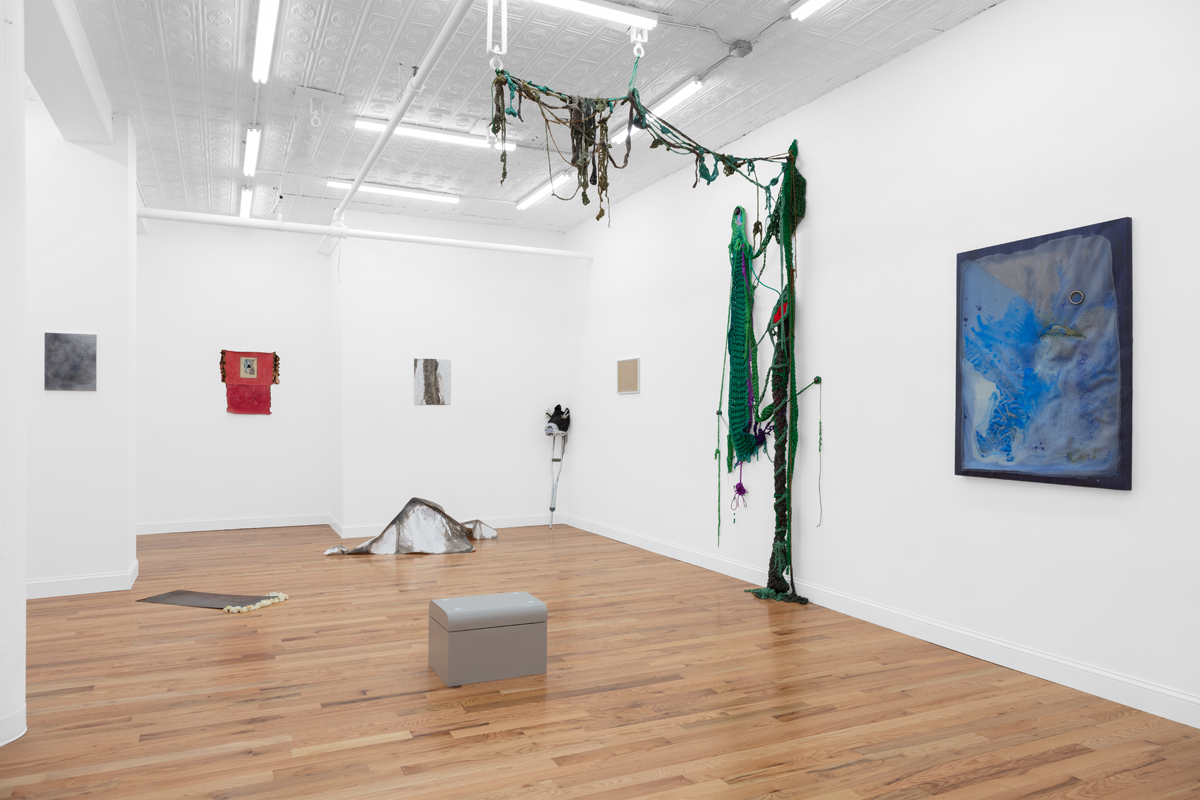
Behind abstract forms, installation view. Courtesy Fragment. Pictured, center foreground: Gordon Hall, Closed Box (Grey and Blue), 2021. Center, back right corner: Jesse Darling, Bucephalus/Comanche (War Horse), 2016.
Behind abstract forms, curated by Alexander Shchurenkov, Fragment, 39 West Fourteenth Street, #308, New York City, through March 26, 2023
• • •
The multigenerational group show at Fragment’s new Union Square space lacks the hallmarks of so-called identity art, or of queer art; there’s no obvious tip-off as to its thirteen contributors’ collective concerns, other than their formal ones. But curator Alexander Shchurenkov proposes that the subtle (mostly) nonrepresentational works in the small gallery engage with “abstraction in relation to healing from trauma, self-care, and the queer body.”
Perhaps because of the challenge to find such content in the ragtag array of modestly sized, solemnly or amiably opaque works on view, I was drawn, right away, to one offering an image to latch on to. Jesse Darling’s sculpture Bucephalus/Comanche (War Horse) (2016) has the appearance of an improvised hobbyhorse. A crutch takes the place of a broomstick, but a sardonically punk equine head, composed of a black trash bag and feathers (among other humble materials), renders the mobility aid unusable, at least for the upright human body that I tried—at first—to imagine it assisting. The piece evokes and undercuts assumptions about (dis)ability, injury, and the recovering body. The artist and theorist Gordon Hall—whose work also appears here and whose writing is cited in Shchurenkov’s exhibition statement—makes a pertinent point, in their 2013 essay “Object Lessons: Thinking Gender Variance through Minimalist Sculpture,” about the capacity of an abstract sculpture’s ambiguous presence or function to prompt us to project a virtual, perhaps differently gendered, body or self—an exercise in kinesthetic imagination.
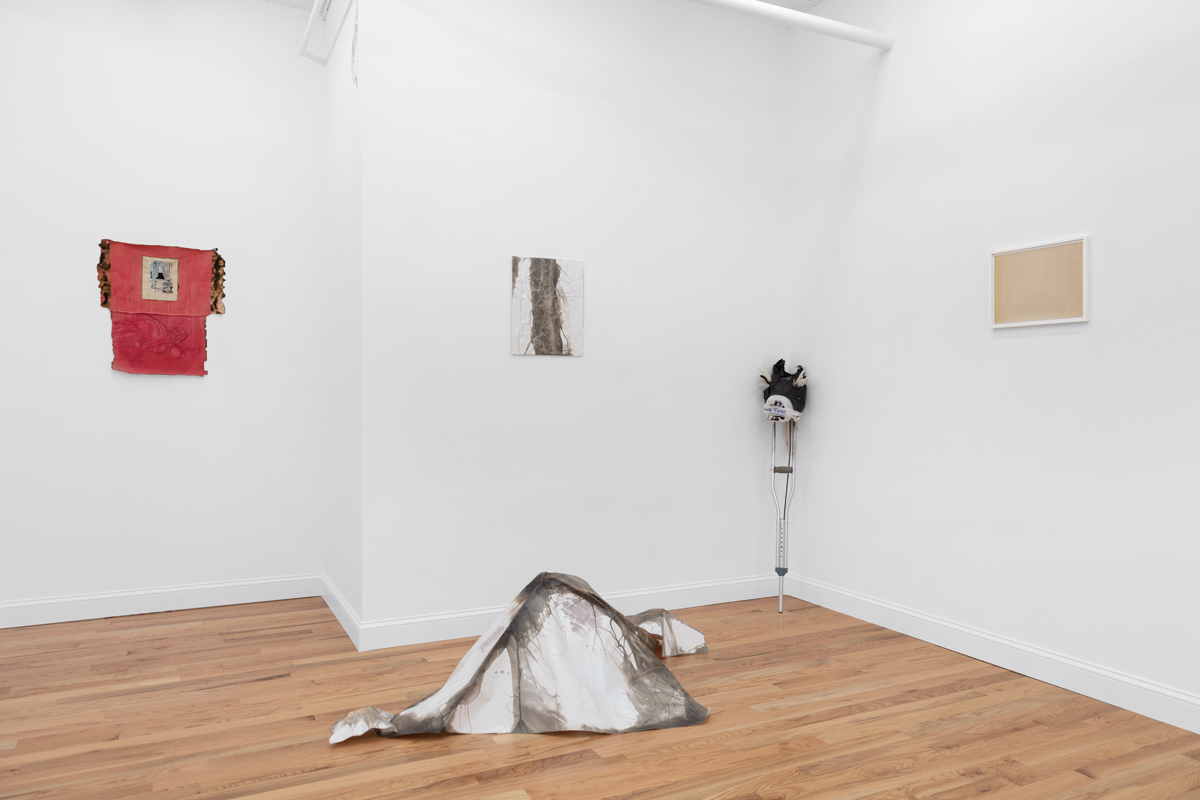
Behind abstract forms, installation view. Courtesy Fragment. Pictured, foreground: Joy Episalla, Foldtogram (RCJ, January 1), parts 1–3, 2023. Center right, back corner: Jesse Darling, Bucephalus/Comanche (War Horse), 2016. Right wall: Wolfgang Tillmans, Silver 203, 2018.
Hall’s exacting, enigmatic Closed Box (Grey and Blue) (2021), a rectangular container, with a rounded lid, resting on the floor, might coax visitors down a perceptual dead end just as assorted boxes in the annals of Minimalism do. But differently from, say, Donald Judd’s open enclosures, it raises the nagging question: What’s inside? Such objects that ask to be opened or moved, or that require a body to reorient or reimagine itself, might also include Joy Episalla’s Foldtogram works (2023)—massive photograms crumpled into sculptural forms. One of them, veined with rivulets of developing chemicals, seems to crawl, supplicating, toward Darling’s horse; or perhaps its damaged convex shape, like Hall’s box, conceals something.
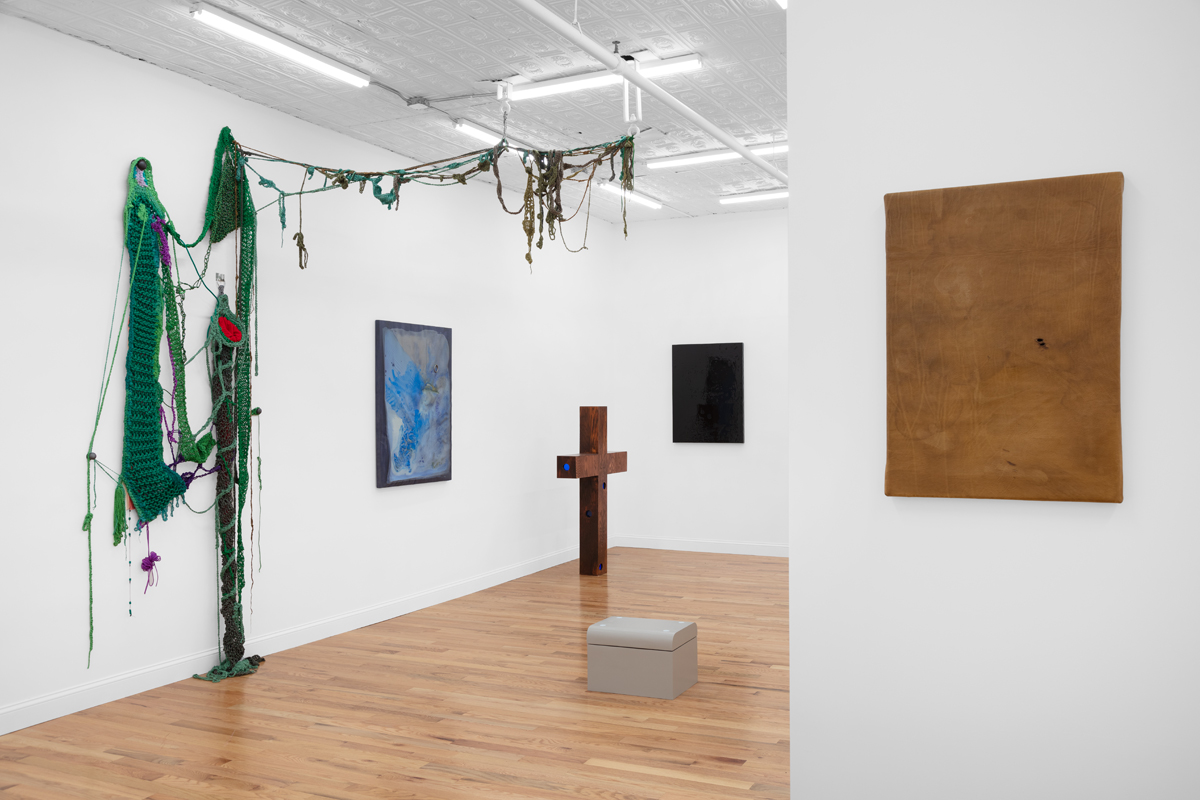
Behind abstract forms, installation view. Courtesy Fragment. Pictured, from left to right, against left wall: Sheila Pepe, In advance of a garden, 2023; Hayden Dunham, winged condensation, 2021; Shikeith, grace comes violently, 2022. Center foreground: Gordon Hall, Closed Box (Grey and Blue), 2021. Far right: Quay Quinn Wolf, Untitled, 2022.
Serendipitous relationships between disparate things seem to occur frequently here, encouraged by evocative or whimsical arrangements. A trio of works, positioned along one wall, are linked by a visual rhyme, each marked by similar-size circles or holes, which lead the eye to connect the dots visually, even if conceptually it can’t quite be done. The mononymous artist Shikeith’s freestanding sculpture, grace comes violently (2022), is a hollow, cross-shaped box of dark-stained plywood with jigsawed orifices. Plugged into the wall with a casually coiled cord, it plays a five-channel video, visible through its peephole apertures. Blue-cast views of bodies, abstracted by close-cropped shots, give the impression of a pulsing interior at odds with the controlled carpentry (and religious significance) of its geometric container.
One also encounters Sheila Pepe’s crocheted soft sculpture, In advance of a garden (2023). The piece is an outlier—and a main attraction—for its unruly green presence as well as its participation in a historical movement to reclaim the crafts and domestic labor of traditional women’s work. Mischievous, even menacing, it pairs orderly swaths or nets of slip-stitched ribbing and tightly knotted cord with tangled dendrons, leaping from wall to ceiling. A red-mouthed, snakelike tube, stocking, or canal hangs from the work’s anchor point, which is—in a butch flourish—a metal hitching ring. It resembles a grommet-like piece of hardware in Hayden Dunham’s nearby composition, winged condensation (2021)—an enlarged petri dish of sorts, which promises, through the interactions of its unstable ingredients (volcanic water, pea flower, chamomile, and mica among them), to change over time. While Pepe’s work suggests an open system, a network that can be expanded, elaborated, or mended, Dunham’s aqueous blue portrait of an ecosystem will, I imagine, become a record of its own decay or death, independent of the artist’s hand.
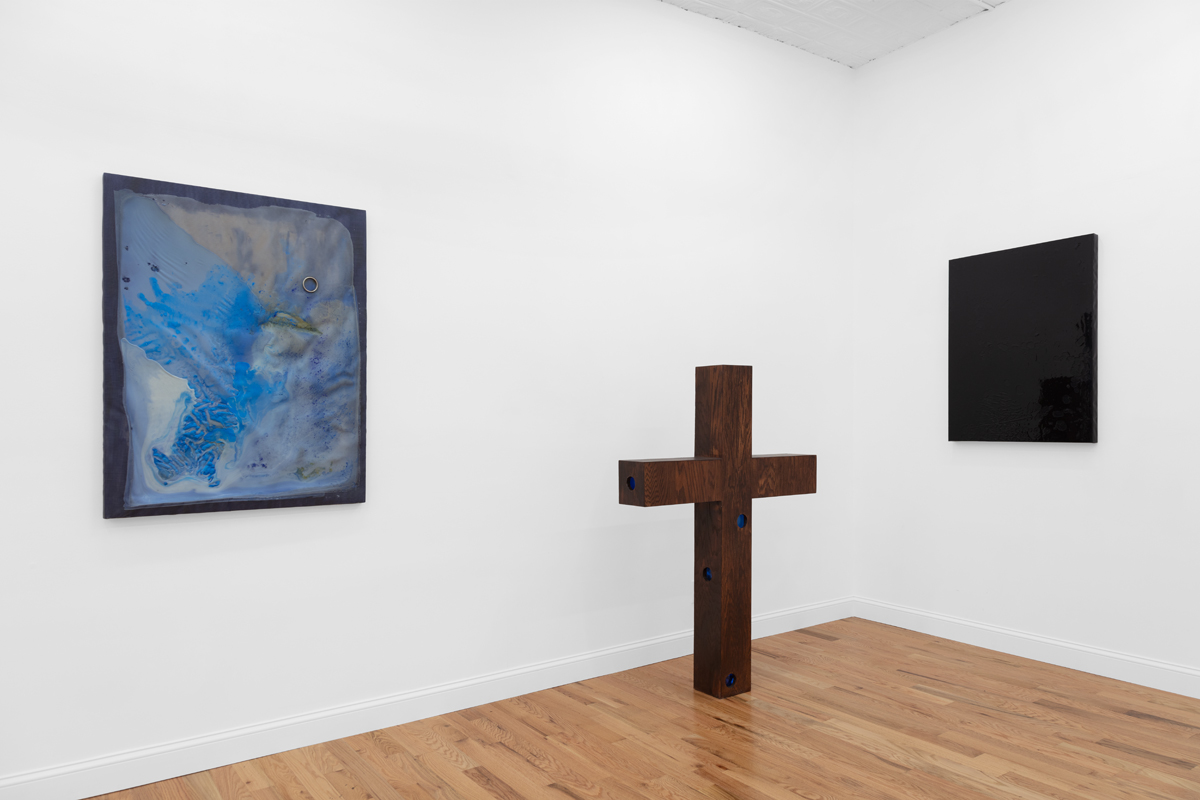
Behind abstract forms, installation view. Courtesy Fragment. Pictured, left to right: Hayden Dunham, winged condensation, 2021; Shikeith, grace comes violently, 2022; Carrie Yamaoka, 40 by 30 (clear/black #3), 2022.
The unpredictable behavior of liquids seems to be the subject of other painterly monochromes—Wolfgang Tillmans’s imageless, viscous taupe expanse in Silver 203 (2018), a chromogenic print produced without a camera (like Episalla’s photographic objects); Carrie Yamaoka’s vinyl and urethane wall-based work 40 by 30 (clear/black #3) (2022), a glossy, dark rectangle of shallow craters and bouncing reflections, which provides the exhibition’s sole moment of real dazzle; and a stained, mottled, dirty-gold painting by Ilya Fedotov-Fedorov, whose poetic title, Salty liquid (2023), underscores its visual allusion to seawater and brackish bodily fluids.
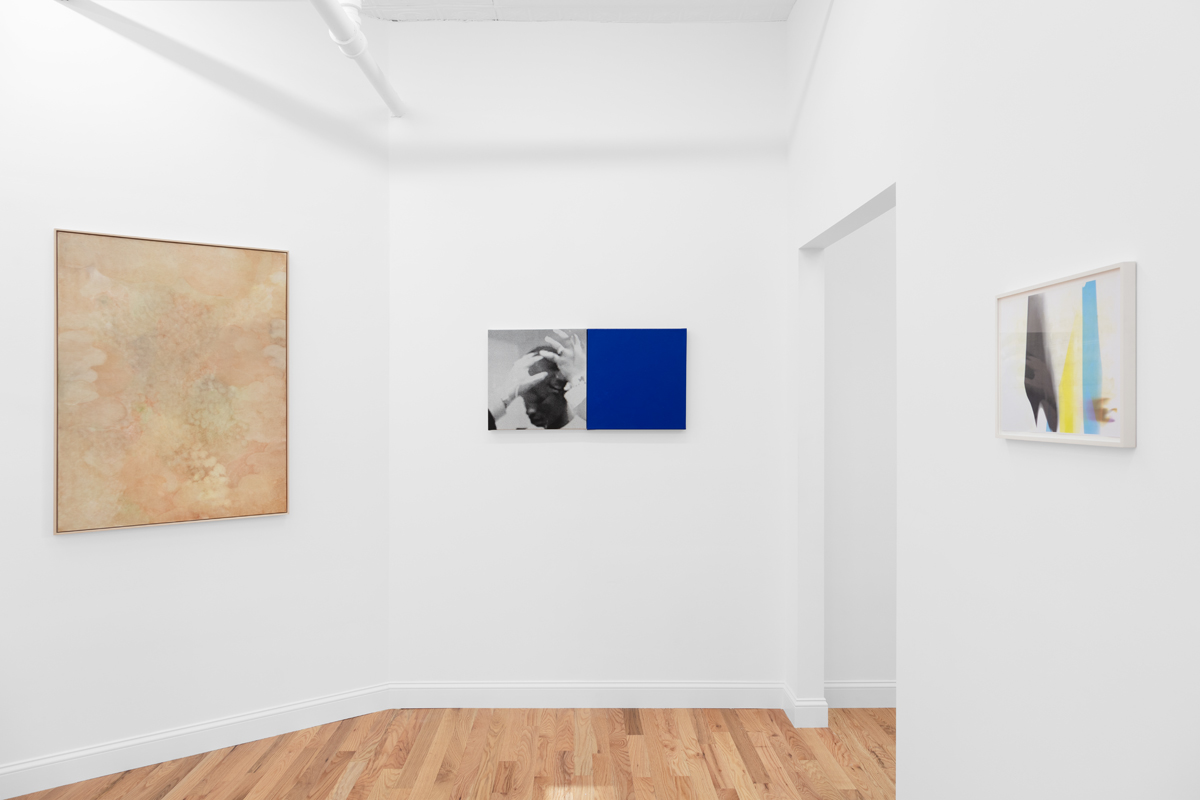
Behind abstract forms, installation view. Courtesy Fragment. Pictured, far left: Ilya Fedotov-Fedorov, Salty liquid, 2023.
Trauma or loss is invoked most explicitly in two works by Quay Quinn Wolf. For one, the artist has pulled a length of tanned leather taut over stretchers. Stained, cloudy, and creased, its surface nicked and punctured, the pebbled hide’s botanical fragrance—a suggestion of care—counters macabre connotations. (Essential oils are listed as a material.) The skin does not evoke a corpse, but a body marked by inevitable injuries, imperfections, or past violence.
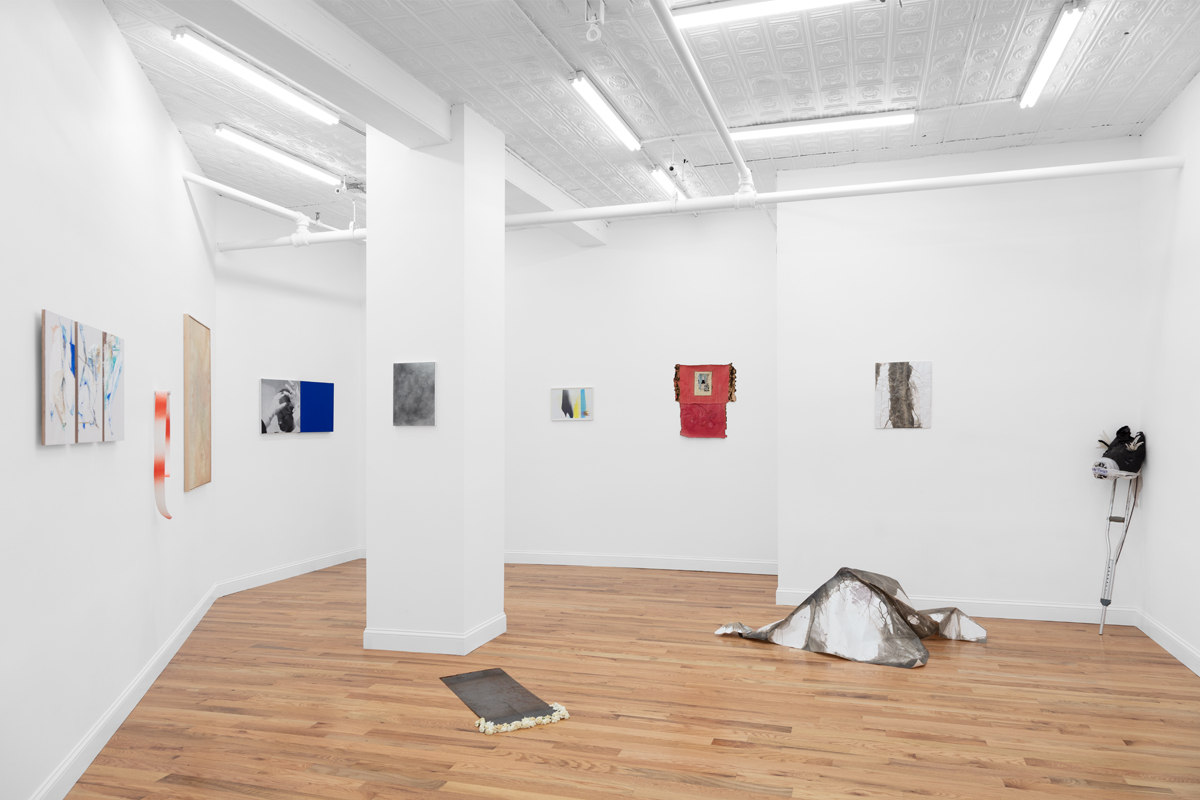
Behind abstract forms, installation view. Courtesy Fragment. Pictured, foreground, center left: Quay Quinn Wolf, ashes to ashes, dust to dust, 2023.
In ashes to ashes, dust to dust (2023), a piece of weathered sheet metal rests almost flat on the floor, one end slightly elevated by a pillow of withering white carnations. The flowers, whose blooms peek out from beneath to resemble a crown of sorts, started out fresh and will end the month desiccated. The piece is a memento mori; it also recalls a grave. And, to me, any metal rectangle placed on the floor of an art gallery conjures the legacy of Carl Andre—both the taciturn radicalism of his work and the strong suspicion that he killed Ana Mendieta, the Cuban American artist who was his wife. Wolf’s piece recalls her art, too, particularly Mendieta’s ephemeral earthworks and photographs referencing Santería and Taíno practices, for which she outlined figures on the ground in various ways, including with flowers.
This is hardly the only way to experience Wolf’s work; it’s my tendency to see the objects here through the lens of Western art history, to call upon past languages of abstraction to understand the exhibition’s enigmatic and open-ended shapes. Minimalism (a clear reference for Hall) looms large in these works, like an absent father—or so I initially thought. But maybe it doesn’t: similar looks, parallel refusals of narrative and illusion, might be arrived at by different routes, turning up at their non-objective destinations corroded, stained, scuffed, and patched up. These process-y works—alchemical, biotic, corporeal, and intimate in character—don’t have all that much to do, at least not directly or legibly, with healing from trauma. But they might establish a counter-lineage, or refuse genealogy entirely, forming a temporary family in a very queer way.
Johanna Fateman is a writer, art critic, and musician. She writes art reviews regularly for the New Yorker and is a contributing editor for Artforum. Her band, Le Tigre, has reunited after seventeen years to tour in 2023.